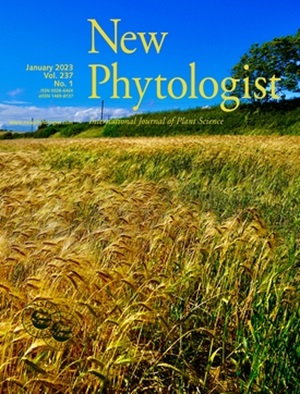Across 33 broad-leaved deciduous woody species, silicon enhances leaf lamina stiffness but not tensile strength whereas cellulose enhances both
IF 8.1
1区 生物学
Q1 PLANT SCIENCES
引用次数: 0
Abstract

在33种阔叶落叶木本物种中,硅提高了叶片刚度,但没有提高抗拉强度,而纤维素提高了两者
硅(Si)被认为是一种代谢更便宜的碳基细胞壁成分的替代品,以支持叶片。然而,作为无定形二氧化硅沉积的硅的生物力学功能与细胞壁成分的不同仍未得到测试。在这里,我们验证了叶片硅浓度较高的物种具有更硬但更脆的叶片层的假设。测定了33种落叶阔叶木本树种的弹性模量(E)、抗拉强度(σmax)、最大应变(εmax)、组织密度、Si和细胞壁组分浓度等力学性能。多元回归结果表明,组织密度、Si浓度和纤维素浓度与εmax呈正相关,与εmax负相关。组织密度和纤维素浓度对σmax的影响最大,而Si浓度对σmax的影响较小。木质素浓度对机械性能无显著影响。这些结果表明,硅可能作为纤维素的替代品,以增加硬度,但不是强度的层。较高的Si浓度降低了εmax,但没有增加σmax,使层状脆性增强。与Si相关的脆性可能解释了使用Si的潜在成本或缺点,这将阐明不同叶片Si浓度的物种之间的权衡。
本文章由计算机程序翻译,如有差异,请以英文原文为准。
求助全文
约1分钟内获得全文
求助全文
来源期刊

New Phytologist
生物-植物科学
自引率
5.30%
发文量
728
期刊介绍:
New Phytologist is an international electronic journal published 24 times a year. It is owned by the New Phytologist Foundation, a non-profit-making charitable organization dedicated to promoting plant science. The journal publishes excellent, novel, rigorous, and timely research and scholarship in plant science and its applications. The articles cover topics in five sections: Physiology & Development, Environment, Interaction, Evolution, and Transformative Plant Biotechnology. These sections encompass intracellular processes, global environmental change, and encourage cross-disciplinary approaches. The journal recognizes the use of techniques from molecular and cell biology, functional genomics, modeling, and system-based approaches in plant science. Abstracting and Indexing Information for New Phytologist includes Academic Search, AgBiotech News & Information, Agroforestry Abstracts, Biochemistry & Biophysics Citation Index, Botanical Pesticides, CAB Abstracts®, Environment Index, Global Health, and Plant Breeding Abstracts, and others.
 求助内容:
求助内容: 应助结果提醒方式:
应助结果提醒方式:


